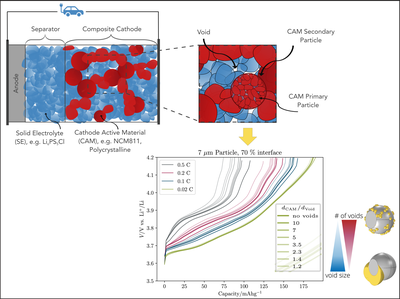April
Picture of the Month - April 2023
Interface Void Effects in Solid-State Battery Electrodes

These (micro-)porosities result from the particle-morphology of the solid electrolyte (SE) and its non-wetting behavior. Apart from the void volume fraction that lies between 6 and 40%, void properties are barely known and depend on the manufacturing method, the materials, the particle size(s), the particle morphologies, and the electrode composition.
To gain insight into the microstructure of solid-state battery composite electrodes the charge behavior of geometry models of one active material particle with varying surface void distribution were studied by electrochemical simulation. Therein, the charge transport in the SE and the active material as well as the charge transfer at their interface are simulated based on the finite-element-method.
The interface voids block active surface area and hinder the charge transfer from one material to the other. This increases the overpotential, particularly at elevated charge rates. Furthermore, fewer, but larger voids entail a higher overpotential than numerous voids that are smaller in size. This indicates that uneven void distributions can evoke inhomogeneous current flow.
The lower part of the image shows simulated charge profiles at various charge rates and void surface distributions, reproduced, and adjusted from Bielefeld et al. 2022.
Ref.: A. Bielefeld, D. A. Weber, R. Ruess, V. Glavas, J. Janek, J. Electrochem. Soc. 2022, 169, 020539, DOI: 10.1149/1945-7111/ac50df.
This picture was submitted by Dr. Anja Bielefeld.
Further insights into the research activities of the ZfM groups can be found in the Gallery.
